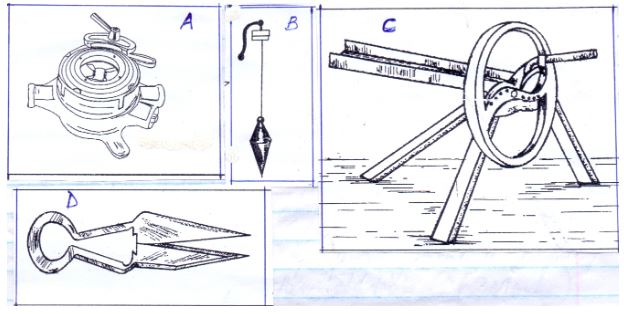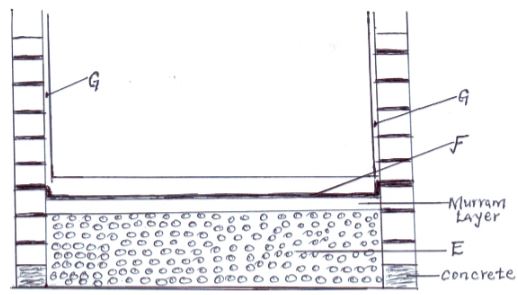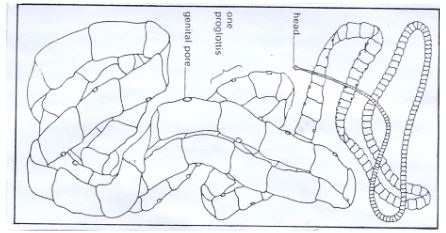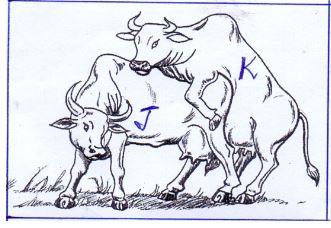- This paper consists of three sections A,B and C
- Answer All the question in section A and B
- Answer ANY TWO questions in section C
- Candidates should answer all the questions in English
SECTION A [30 MARKS]
Answer all the questions in this section in the spaces provided .
- Name two dairy breeds of goats .[2marks]
- Give four characteristics of clean and high quality milk .[2marks]
- Name two classes of livestock feedstuff .[1mark]
- Give three systems of out breeding .[1.5marks]
- Give the pathogens that cause the following livestock diseases .
- Anthrax [0.5marks]…………………………………………………………………………………………..
- Gumboro [0.5marks]…………………………………………………………………………………………
- State two reasons for hoof trimming in livestock .[1mark]
- Give four symptoms of Newcastle disease .[2marks]
- State four reasons why bees swarming (2mks)
- Give four pre disposing factors of mastitis in dairy cows .[2marks]
- State four routine management practices carried out on a replacement stock that is a heifer.[2marks]
- Outline two control measures of roundworms. [1mark]
- Give two methods of selection . [1mark]
-
- Name a pig breed that is purely black with a long back and drooping ears [0.5mark
- Name four materials collected by bees . [2marks]
- State four mechanical methods of controlling ticks .[2marks]
- Give two roles of ovaries in a cows reproductive system . [1mark]
- State four importance of identification in livestock. [2marks]
- Give two roles of a bee drone . [1 mark ]
- State four management practices carried out in a deep litter system of poultry keeping . [2marks]
- Name two functions of lubrication system .[1mark]
SECTION B [20MARKS]
Answer all the questions in this section in the spaces provided .
- The diagrams below represent some farm tools and equipment .Study them and answer the questions that follow .
- Identify the tools labeled A and B (2 marks)
- State one use of each of the tools labeled C and D (2 marks)
- Explain one maintenance practice carried out on tool D . [1mk.]
- The diagram below represents a foundation of a farm structure .Study it and answer questions that follow .
- Identify the parts labeled E and F . (2 marks)
- State two uses of part labeled F in a foundation structure . [2mks.]
- What ingredients are used to complete part G . [1mk.]
- The diagram below illustrates an internal parasite of livestock .
- Identify the parasite above . [1mk.]
- Name two common species of the parasite illustrated above . [2mks.]
- Give two control measures of the above parasite . [2mks.]
- Study the diagram below and answer questions that follow .
- Which of the above cows shows the signs of heat ? [1mk.]
- Give one reason to confirm your answer in [a] above .
- State two benefits of natural mating system . [2mks.]
- Name a disease that is easily spread by this method of mating . [1mk.]
SECTION C [40MARKS]
Answer any two questions from this section in the spaces provided .
-
- Describe six Advantages of battery cage system of rearing poultry . [6mks.]
- Explain six requirement of calf pens. [6mks.]
- Explain 4 factors considered when siting farm structures .[4mks.]
- Explain 4 essentials of clean milk production (4 mkS)
-
- Describe anthrax disease under the following sub headings .
- Animals affected . [2marks]
- Causal organism . [1 mark ]
- Symptoms of attack . [ 5 marks]
- Control measures . [2 marks ]
- Describe the lifecycle of one host tick.[5marks]
- STATE five Characteristics of eggs used for incubation . [5marks]
- Describe anthrax disease under the following sub headings .
-
- State differences between petrol and diesel engine [5mks.]
- Explain five factors considered when siting a fish pond.[5mks.]
- Explain the predisposing factors of livestock diseases 5mks

MARKING SCHEME
SECTION A [30 MARKS]
-
- Saanen ;
- Toggenburg ;
- British alpine ;
- Anglo-Nubian ;
- Jamnapari . [2mks.]
-
- Free from disease pathogens ;
- Free from hair , dirt ,dust ;
- Good keeping quality ;
- Good flavor ;
- Free from adulteration with water ; [2mks.]
-
- Roughage ;
- Concentrates . [1mk.]
-
- Out crossing ;
- Cross breeding ;
- Up grading / grading up . [ 1.5 mks]
-
- Bacterium/Bacillus anthracis . [0.5mk.]
- Virus / Birna virus [0.5 mk.]
-
- Facilitate easy movement ;
- Control foot rot disease ;
- Prevent ram from injuring ewe during tupping . [ 1mk.]
-
- Difficulties in breathing ;
- Beaks remain wide open with strained necks ;
- Dullness of birds ;
- Birds stand with eyes closed ;
- Loss of appetite ;
- Nasal discharge ;
- Walking with a staggering motion ;
- Drooping wings and beaks ;
- Watery green diarrhea ;
- Soft shelled eggs .
-
- The population has grown too large and the hive is too small to accommodate all the bees.
- There's not enough room to build more honey stores.
- The temperature is too hot. With higher temperatures, more space is needed for each bee to maintain a cooler temperature.
- The hive does not have proper ventilation and drainage. If the bees cannot ventilate the hive properly, temperatures rise, and they will likely move out of the hive.
- High humidity and poor ventilation make the hive unbearable for the bees.
- Problems with the queen. Sometimes older queens have a tendency to fail to produce enough eggs in times of high honey production of the colony..[2mks.]
- The population has grown too large and the hive is too small to accommodate all the bees.
-
- Age ,old animals more prone ;
- Stage of lactation ;
- Udder attachment ;
- Incomplete milking ;
- Wounds on teats ;
- Poor sanitation ;
- Poor milking .[2mks.]
-
- Control internal and external parasites ;
- Control diseases ;
- Effect identification ;
- Remove extra teats ;
- Effect dehorning .[2marks]
-
- Avoid contaminating livestock feeds with faeces ;
- Initiate rotational grazing to break the cycle ;
- Improve sanitation by removal of dung ;
- Use appropriate antihelminths ;
- Use latrines .[1mk.]
-
- Straighten loose wires
- Splice broken wires ;
- Replace worn out posts;
- Replace broken droppers and brace posts .[1mk.]
-
-
- Duroc jersey [0.5mk.]
-
- Nectar;
- Pollen ;
- Propolis ;
- water .[2mks.]
-
-
- Burning the infected pastures;
- Altering the environment by ploughing or top dressing with lime;
- Fencing off the pasture ;
- Starving the ticks to death by interrupting the lifecycle ;
- Picking and killing .[2mks.]
-
- Produce female gametes ;
- Produce hormones that induce estrus .[1mk.]
-
- Selection for breeding.
- Facilitates treatment of sick animals.
- Culling of poor animals.
- Identification for special feeding.
- For record keeping on an animal.
- Identification of lost/stolen animal.[2mks]
-
- Mates with the queen ;
- Flaps the wings controlling temperature .[1mk.]
-
- Turning litter ;
- Cleaning feed and water troughs ;
- Egg collection twice a day ;
- Food and water provision adlibitum ;
- Adequate perches ;
- Adequate laying boxes ;
- Hang green vegetables to avoid boredom .[2mks]
-
- Connection or disconnection of the driveshaft;
- Take off smoothly without a jerk. [1mk.]
SECTION B [20MARKS]
-
-
- A….stock and die [1mk.]
- B…..plumb bob [1mk.]
-
- C…chops forage for livestock. [1mk.]
- D….cuts wool from a sheep’s body [1mk.]
- Cleaning after use;-sharpening the blades. [1mk.]
-
-
-
- E…Hardcore [1mk.]
- F….Damp proof material /PVC [polyvinyl chloride] [1mk.]
-
- Prevents water rising beyond the floor or wall.
- Prevents insects beyond the floor or wall. [2mka.]
-
- sand;
- cement [1mk.]
-
-
- Tapeworm [1mk.]
-
- Taenia solium/pig tapeworm ;
- Taenia saginata/beef tapeworm [2mk.]
-
- Suitable antihelminths;
- Disinfect livestock houses;
- Rotational grazing to break lifecycle;
- Feed troughs and water troughs kept clean;
- Proper disposal of human faeces;
- Meat inspection;
- Proper meat cooking. [2mks.]
-
- J [1Mk.]
- J stands still when mounted by K .[1mk.]
-
- More accurate due to heat detection by males;
- Less laborious;
- Useful when heat signs cannot be detected. [2mks.]
-
- Brucellosis/contagious abortion;
- Trichomonas spp. [1mk.]
SECTION C 40 MARKS]
Answer any TWO questions from this section in the spaces provided .
-
-
- Easy to keep individual production records.
- Controls cannibalism and egg eating.
- No contamination of water and feed,
- Birds are not exposed to predators, parasites and diseases.
- Facilitates culling and handling
- Easy to collect eggs.
- Egg losses are reduced.
- Many birds are kept in a given area/high stocking rate
- Eliminates broodiness.
- Birds still have tender meat at culling due to confinement.
- Facilitates mechanization,
- Keeps eggs clean.
- Sick birds can be detected easily for isolation.
- Low labour requirement.
- Higher egg production due to less energy spent [6marks]
- Easy to keep individual production records.
-
- Ensure its-pens should have concrete floors to facilitate cleaning
- Make dry and warm- dry litter should be placed on the floor to avoid dampness/wetness.
- Roof should not leak/avoid spilling water on the floor to discourage dampness and wetness of the litter
- Adequate space: Should be spacious for exercise, feeding and watering of calves.
- Proper lighting - should be well lit as light is necessary for synthesis of vitamin D.
- Proper drainage - should be constructed on a well-drained place to avoid dampness
- Draught free - to prevent entry of cold winds and discourage infections like pneumonia
- Proper ventilation - to allow free air circulation
- Single housing - calves should be housed singly to prevent licking one another which can lead to formation of hair - balls in
- the rumen.[6mks]
- Ensure its-pens should have concrete floors to facilitate cleaning
-
- Location of the homestead
- Accessibility
- Security
- Drainage
- Direction of prevailing wind.
- Relationship between the structures.
- Framers tastes and preference
- Topography
- Proximity of amenities water and electricity.
- Government regulations. [8marks]
- Location of the homestead
-
- Milking equipment should be clean
- Clean milking parlour/shed.
- The udder should be cleaned before milking.
- The milkman should be clean and healthy.
- The cows should be tested for mastitis before milking.
- Cows with mastitis should be milked last and milk disposed of.
- The milk should be sieved/filtered after milkin2.
- The milk should be stored in a cool dry place/proper storage.
- Cow should be healthy/check the cows regularly for milk-borne disease.
- The milk should be covered after milking.
- Feeds that can taint milk should be avoided/equipment that can taint milk should be avoided.
- Milk should be cooled immediately to reduce bacterial multiplication
- Chip hair around udder and flank.
- Milking equipment should be clean
-
-
-
- Ruminants [cattle ,sheep ,goats ] , pigs ,wild animals that are cloven hooves.[2mks.]
- Virus. [1mk.]
-
- Fever /high temperature;
- staring coat;
- Discharge from mouth and nose ;
- Watery eyes ;
- Diarrhea and dysentery ;
- Mouth and nose mucous membranes are red ;
- Emaciation in animals ;
- Grinding teeth;
- Death in 2-10 days after incubation. [5mks.]
-
- Vaccination every 6 months;
- Quarantine after an outbreak;
- Nurse animals with a disinfectant on the wounds;
- All affected animals killed. [2mks.]
-
- Eggs hatch larvae which climb onto the host and feed on blood;
- Engorged larvae moult, nymphs emerge, feed on blood;
- Engorged nymphs moult, adults emerge;
- Adults feed on blood and mate;
- Engorged female falls to ground and lays eggs;.[5mks.]
- Eggs hatch larvae which climb onto the host and feed on blood;
-
- Drying of farm produce ;
- Heating water for dairy and domestic use ;
- Processing/distillation of clean drinking water ;
- Generate electricity for lighting ;
- Electricity to run milk coolants ,milking machines ,brooders ,incubators ;
- Used for cooking with special cookers .[5mks.]
- Drying of farm produce ;
-
-
-
Petrol engine Diesel engine -It has carburetor
-Fuel and air are mixed in the carburetor before it gets into the engine
-Fuel is ignited by an electric spark
-It produces little smoke because petrol is completely burnt
-Petrol engine is light in weight and suited for light duties-It has an injection pump
-The fuel and air are mixed within the cylinder
-Fuel is ignited by compression of air and fuel mixture in the cylinder
-It produces alot of smoke since the diesel is not completely burnt
-It is relatively heavy in weight and suited for heavy duties -
- Soil type.
- Topography.
- Sources of water.
- Closeness to homestead/accessibility.
- Closeness to the market centre.
- Security
-
- Sex
- Colour
- Age
- Physiological condition eg pregnancy, lactation;
- Physical injuries
-
Download Agriculture Paper 2 Questions and Answers - ACK Diocese Mumias Joint Evaluation Mock 2022.
Tap Here to Download for 50/-
Get on WhatsApp for 50/-
Why download?
- ✔ To read offline at any time.
- ✔ To Print at your convenience
- ✔ Share Easily with Friends / Students




